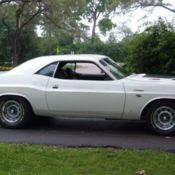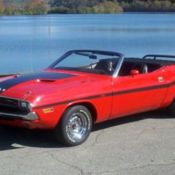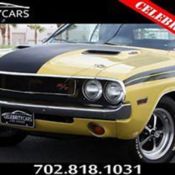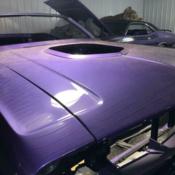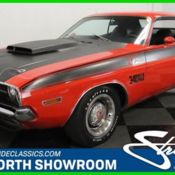1970 Dodge Challenger Convertible R/T 440 Six Pack A/T Tribute Car Vegas Trades
| Condition: | Used |
| Make: | Dodge |
| Model: | Challenger |
| SubModel: | 1970 Dodge Challenger R/T 440 Six Pack |
| Type: | Coupe |
| Doors: | 2 |
| Year: | 1970 |
| Mileage: | 54,329 |
| VIN: | JH27C0B107437 |
| Color: | Yellow |
| Fuel: | Other |
| Transmission: | Automatic |
| Interior color: | White |
| Vehicle Title: | Clear |
| Item location: | Las Vegas, Nevada, United States |
| Extras |
| Listed by | Private seller |
Description of 1970 Dodge Challenger 1970 Dodge Challenger R/T 440 Six Pack |
|
1970 Dodge Challenger Convertible R/T 440 Six Pack A/T Tribute Car Las Vegas Trades 1970 Dodge Challenger Convertible R/T 440 Six Pack 1970 Dodge Challenger Convertible R/T 440 Six Pack Tribute This 1970 Challenger R/T Convertible was originally a Challenger convertible with a 225 cu.in. 1 bbl. 6 cylinder in which only 378 In-line (6) Six Cylinder Convertibles were produced. This was found by decoding the vin. The 'J' in the vin indicates this. The 'fender tag' was removed from the car at some point. Therefore the cars original color, tc. cannot be confirmed. Cosmetically this car is now represented as a Challenger R/T 440 SIX PACK Convertible Tribute car. The car after completing a Rotisserie restoration now is furnished in beautiful "Banana" Yellow with Black R/T stripes and badging, lack Soft Top with stark white vinyl interior with wood grain trim. It features the 440 SIX PACK hood with ram air style scoops, odge R/T rally wheels, istol grip shifter, ucket seats, enter console, achometer, ower soft top, 40 Magnum V8 with 3x2 bbl "SIX PACK", -speed TorqueFlite automatic, ower Steering, nd Compact spare to name a few. This Challenger runs strong, ooks great with no major problems found. It is a rust free car, owever cosmetically we did discover what appears to be some bodywork bondo bubbling appearing on the lower quarter panels on both sides. There is no broken paint as of yet, ut there is some blistering in these said locations. Don't miss out on this beautiful tribute Challenger R/T 440 "Six Pack" Tribute car!! ---------------------------------------------------------------------------------------------- Dodge Challenger (Factory Info & Histroy) The Dodge Challenger is the name of three different generations of American automobiles marketed by the Dodge division of Chrysler. The Dodge Silver Challenger was produced from 1958 to 1959. From 1969 to 1974, he first generation Dodge Challenger pony car was built using the Chrysler E platform, haring major components with the Plymouth Barracuda. The second generation, rom 1978 to 1983, as a badge engineered Mitsubishi Galant Lambda. The third, nd current generation, as introduced in early 2008 as a rival to the evolved fifth generation Ford Mustang and the fifth generation Chevrolet Camaro. First generation (1970-1974) Overview Production 1969-1974 Assembly Hamtramck, ichigan, nited States Los Angeles, alifornia, nited States Designer Carl Cameron (1968) Body and chassis Body style 2-door convertible 2-door hardtop Platform E-body Related Plymouth Barracuda Powertrain Engine 198 cu in (3.24 L) Slant 6 I6 225 cu in (3.69 L) Slant 6 I6 318 cu in (5.21 L) LA V8 340 cu in (5.6 L) LA V8 360 cu in (5.9 L) LA V8 383 cu in (6.28 L) B V8 426 cu in (6.98 L) Hemi V8 440 cu in (7.2 L) RB V8 Transmission 3-speed manual 4-speed manual 3-speed TorqueFlite automatic Dimensions Wheelbase 110.0 in (2,790 mm) Length 191.3 in (4,860 mm)[4] Width 76.1 in (1,930 mm) Height 50.9 in (1,290 mm) The Challenger was described in a book about 1960s American cars as Dodge's "answer to the Mustang and Camaro." Introduced in fall 1969 for the 1970 model year, t was one of two Chrysler E-body cars, he other being the slightly smaller Plymouth Barracuda. "Both the Challenger and Barracuda were available in a staggering number of trim and option levels" and were intended "to compete against cars like the Chevrolet Camaro and Ford Mustang, nd to do it while offering virtually every engine in Chrysler's inventory." However, he 1970 Challenger was "a rather late response to the ponycar wave the Ford Mustang had started" with its introduction in April 1964. In his book Hemi Muscle Cars, obert Genat wrote that the Challenger was conceived in the late 1960s as Dodge's equivalent of the Plymouth Barracuda, nd that the Barracuda was designed to compete against the Mustang. The 1964 Barracuda was actually the first car in this sporty car segment by a few weeks, ut was quickly overshadowed by the release of the segment defining Mustang (the segment being referred to as "Pony Car"). He added that Chrysler intended the new 1970 Dodge as "the most potent ponycar ever," and positioned it "to compete against the Mercury Cougar and Pontiac Firebird." Genat also noted that the "Barracuda was intended to compete in the marketplace with the Mustang and Camaro/Firebird, hile the Dodge was to be positioned against the Cougar" and other more luxury-type musclecars. The Challenger's longer wheelbase, arger dimensions and more luxurious interior were prompted by the launch of the 1967 Mercury Cougar, ikewise a bigger, ore luxurious and more expensive pony car aimed at affluent young American buyers. The wheelbase, t 110 inches (2,794 mm), as two inches longer than the Barracuda, nd the Dodge differed substantially from the Plymouth in its outer sheetmetal, uch as the Cougar differed from the shorter-wheelbase Ford Mustang. Air conditioning and a rear window defogger were optional. Exterior design was done by Carl Cameron, ho also did the exterior for the 1966 Dodge Charger. Cameron based the 1970 Challenger grille off an older sketch of his 1966 Charger prototype that was to have a turbine engine. The Charger never got the turbine, ut the Challenger featured that car's grille. Although the Challenger was well received by the public (with 76,935 produced for the 1970 model year), t was criticized by the press, nd the pony car segment was already declining by the time the Challenger arrived. Sales fell dramatically after 1970, nd though sales rose for the 1973 model year with over 27,800 cars being sold, hallenger production ceased midway through the 1974 model year. A total of 165,437 Challengers were sold over this generation's lifespan. A 1970 Challenger R/T 440 Magnum was featured in the existentialist 1971 film Vanishing Point. For the 1973-74 season of the TV show Mannix the title character drove a 1974 Challenger Rallye, hich was specially ordered and built for the show. The car had every option available including the 360 4-barrel engine and the rare factory sunroof. The Challenger was available as a two-door in either a hardtop coupe or a convertible body design, nd in two models for its introductory year. The base model was the "Challenger" with either a I6 or V8 engine, s well as a "Challenger R/T" that included a 383 cu in (6.28 L) V8. The Special Edition or "Challenger SE" that added a number of appearance, onvenience, nd comfort items was "available as a model in either the Challenger R/T or Challenger."The standard engine on the base model was the 225 cu in (3.7 L) six-cylinder. The standard engine on the V8 was the 230 bhp (171.5 kW) 318 cu in (5.2 L) V8 with a 2-barrel carburetor. For 1970, he optional engines included the 340 and 383 cu in (5.6 and 6.3 L), s well as the 440 and 426 cu in (7.2 and 7.0 L) V8s, ll with a standard 3-speed manual transmission, xcept for the 290 bhp (216.3 kW) 383 CID engine, hich was available only with the TorqueFlite automatic transmission. A 4-speed manual was optional on all engines except the 225 CID I6 and the 2-barrel 383 CID V8. Collectability Although few mourned the end of the E-body models, he passage of time has created legends and highlighted the unique personalities of both the Challenger and the Barracuda. With a low total production, s well as low survivability over the years, ny Challenger is worth a substantial amount of money. In a historic review, he editors of Edmunds Inside Line ranked these models as: 1970 was a "great" year, 971 was a "good" one, nd then "three progressively lousier ones" (1972-1974). With total sales and production off by 2/3 from 1970, he performance engine 1971 Challengers are the most rare. Sales and production of the 1973 cars (with only two V8s available) actually exceeded 1971 by approximately 1,700 cars. This may be explained by 1973 being a very good year for the U.S. auto industry in general and an increased interest in Chrysler (the Plymouth Barracuda and Plymouth Road Runner also saw sales increases) performance cars. Nowadays, ou can expand your collection with various restored 1970's Challengers, r with some special, ne-off Challenger, ike this 1970 "Insidious" Challenger that was created, nd sold, ew years ago. Production numbers 1970 = 76,935 *includes 2,539 T/As Hardtop I6: 9,929 Hardtop V8:. 39,350* Sports hardtop I6: 350 Sports hardtop V8: 5,873 Convertible I6: 378 Convertible V8: 2,543 Hardtop R/T: 13,796 Special Edition hardtop R/T: 3,753 Convertible R/T: 963 WALK AROUND VIDEO View on YouTube WE DO REQUIRE A $500 DEPOSIT VIA CREDIT CARD OR CASH IN PERSON WITHIN 24 HOURS AUCTION OR LISTING CLOSE. WE DO NOT ACCEPT PAYPAL. |
 Home
Home Contact us
Contact us NEWEST CARS
NEWEST CARS SELL YOUR CAR
SELL YOUR CAR FAQ
FAQ
